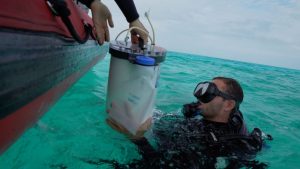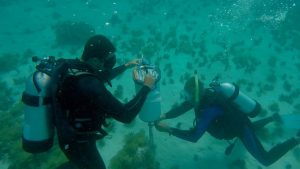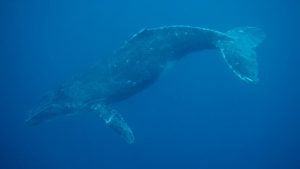Bob Carpenter surveys the seafloor surrounding the research vessel Anthias as it glides over Blue Lagoon, the largest part of the reef that envelops Heron Island. He and his team, which is conducting the in-water validation of reef metabolism for NASA’s Coral Reef Airborne Laboratory (CORAL) mission, are searching for a good spot among the numerous small patch reefs in the lagoon to erect what he calls an “underwater construction project.”
The boat stops to look at an area more closely.“It’s looking pretty algalicious here,” says Carpenter with a laugh, knowing he just made up a word. He asks skipper Sam Ginther, a research technician at California State University, Northridge, where Carpenter is a professor of biology, to continue to another location.

Sam Ginther, California State University, Northridge, goes into the water Credit: NASA-JPL/Alan Buis
Carpenter has brought his three-person team to the Great Barrier Reef to make in-water measurements of the productivity and calcification of the community of living organisms found on the seafloor here at Heron Island and also at Lizard Island, on the northern Great Barrier Reef. Their data will help the CORAL team validate CORAL’s advanced Level 4 science products.
It’s mid-September and day two out in the field for the team at Heron. They’ll be here for another week, installing instruments at up to 10 sites around Heron Reef. Yesterday they deployed a float called a drogue to track the paths of currents below the water surface to help guide their placement of instruments. On today’s trip they’ll be deploying two types of instruments: samplers that collect water for later analysis in the lab, and gradient flux instruments that measure oxygen and water flow.
At this location they are deploying the “gradient flux” instruments. The instruments will measure two of the three key aspects of reef metabolism his team is studying: primary productivity and respiration (the third is calcification). Metabolism refers to the processes by which reef communities acquire energy for growth and build their limestone skeletons.
The team must work quickly, because the high and low tides here at this time of the month are extreme.
“I think the difference at this time of day is 7.2 feet, so we need to get out to the lagoon when it’s high tide so we’ll have deep enough water to navigate in when we’re entering the lagoon and going over the reef crest,” says Chiara Pisapia, a postdoctoral researcher from Italy who came to Australia six years ago and recently completed her postdoc at James Cook University. She’s now joining Bob’s group at CSUN.
“If we’re still in the lagoon when the tide goes down, we’ll be stuck here until the next high tide.” The team will have a little more than two hours in the lagoon, which averages about 11 feet in depth, to accomplish today’s tasks. The instruments have to be placed where they won’t go dry when the tide goes out.

Sam Ginther, California State University, Northridge, takes a gradient flux instrument from Chiara Pisapia, James Cook University. Credit: NASA-JPL/Jim Round
The gradient flux system—oxygen sensors and acoustic Doppler velocimeters—will be mounted at two heights above the seafloor. The bottom instruments are placed 4 inches above the flora and fauna on the seafloor, with the top instruments placed 43 inches above the seafloor. The method they’re using relies on the flow of water to carry water and oxygen (either produced by photosynthesis or taken up by respiration) past the instruments.
“The water here doesn’t always flow in the same direction, so we’re looking for a coral patch that’s fairly uniform where the water will carry data signals on the surrounding habitat past these sensors,” Carpenter says. “We’ll then place the sensors right in the center of that patch so they will integrate the metabolism from that point to a larger scale: anywhere from 108 square feet to perhaps 538 square feet, depending on the speed of the water flow. Since the pixel size for PRISM’s spectrometer on the Gulfstream IV aircraft is 86 square feet, we’re able to match its scale really well.”
The team locates a suitable spot in the lagoon and gets to work, donning scuba gear and taking the equipment they will need down to the seafloor below. The equipment includes a tall cylindrical stand with adjustable brackets and clamps that hold the four gradient flux instruments in place at fixed heights to eliminate any bias in the measurements.
The sensors will continuously measure oxygen and water flow across the layer of water directly above the organism-covered seafloor, providing measurements of the area’s net productivity during the day and its respiration at night. Upon completing the installation, the divers release a special yellowish-green, reef-safe dye, which allows them to verify that water is flowing across the instruments. A member of the team notes the location of the installation using a portable GPS receiver. The team will repeat the process tomorrow, moving the instruments to a new location on the reef every 24 hours.

Bob Carpenter and Sam Ginther, both of California State University, Northridge, set up gradient flux instruments. Credit: Chiara Pisapia.
Earlier in the day, the team used GPS coordinates to locate instruments they installed in the lagoon yesterday that are used to measure reef metabolism, and placed two CSUN-built integrated water samplers at the same locations. The water samplers were placed about 1,312 feet apart, one downstream from the other, moored to the seafloor. They remain in place for five consecutive days.
The team swaps the sample bags out and takes them back to the lab to analyze for total alkalinity. Changes in total alkalinity can be used to estimate reef calcification, a key element of reef metabolism.
Calcification is the secretion of calcium carbonate—what we think of as limestone. Coral skeletons and other calcifying organisms such as calcified algae build the reef framework, allowing reef systems to grow vertically over time to create the largest biogenic structures on Earth. The process of calcification is fundamental to the growth of corals and reefs in general. As climate changes and sea surface temperature and ocean acidification increase, calcification is predicted to decrease. In fact, experiments are showing that calcification decreases with simulated increases in ocean acidification and temperature.
Carpenter says the team wants to sample as many different habitats as they can so that CORAL’s benthic cover in-water validation team will know exactly what the metabolism is for these different habitat patches. “We install the instruments in a location, leave them for about 24 hours, and mark them with a float,” he says. “Then the benthic cover team comes the next day and creates their photo mosaic of the area. So we end up knowing exactly what’s there and exactly what the rates of metabolism were in those same patches. We can then match those different habitats with PRISM data to hopefully extrapolate what the reef is doing on a larger scale.”
Their work for the day complete, Pisapia takes the helm and carefully navigates the boat through the shallow corals out of the lagoon and back to the harbor. Tomorrow they’ll go out again and move another set of instruments. Their work here on Heron Island will be followed by several months of data processing and analysis.

A young humpback whale swims in the waters off Heron Island. Credit: Bermuda Institute of Ocean Sciences/Stacy Peltier
As they head for shore, a large humpback whale and her calf breach out of the water a short distance away. They stop for a minute to watch in awe. Life is good.
by Alan Buis / OFF HERON ISLAND, QUEENSLAND, AUSTRALIA /

